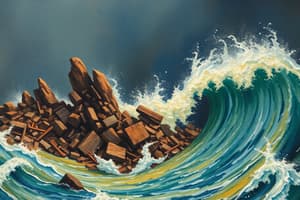Podcast
Questions and Answers
What is the primary source of force that generates an earthquake?
What is the primary source of force that generates an earthquake?
The primary source of force that generates an earthquake is called the hypocenter.
How does ground shaking occur during an earthquake?
How does ground shaking occur during an earthquake?
Ground shaking occurs when seismic waves radiate energy released by stored stress in rocks during an earthquake.
What is liquefaction and when does it typically occur?
What is liquefaction and when does it typically occur?
Liquefaction is a phenomenon that occurs when the strength of saturated soil is reduced by earthquake shaking.
Differentiate between left lateral and right lateral strike-slip faults.
Differentiate between left lateral and right lateral strike-slip faults.
Define ground rupture in the context of earthquakes.
Define ground rupture in the context of earthquakes.
What causes tsunami waves during an earthquake?
What causes tsunami waves during an earthquake?
Explain the concepts of subsidence and lateral spreading during an earthquake.
Explain the concepts of subsidence and lateral spreading during an earthquake.
What type of geological hazard is often triggered by strong ground motions during an earthquake?
What type of geological hazard is often triggered by strong ground motions during an earthquake?
Which of the following is NOT a potential earthquake hazard?
Which of the following is NOT a potential earthquake hazard?
The epicenter of an earthquake is located directly below the hypocenter.
The epicenter of an earthquake is located directly below the hypocenter.
What phenomenon occurs when the strength of saturated soil is reduced due to seismic waves?
What phenomenon occurs when the strength of saturated soil is reduced due to seismic waves?
During an earthquake, ground ______ occurs when a fault rupture extends to the Earth's surface.
During an earthquake, ground ______ occurs when a fault rupture extends to the Earth's surface.
Match the following earthquake hazards with their descriptions:
Match the following earthquake hazards with their descriptions:
What can cause lateral spreading in relation to earthquakes?
What can cause lateral spreading in relation to earthquakes?
Earthquake-induced landslides occur only on steep slopes.
Earthquake-induced landslides occur only on steep slopes.
What term describes the sinking of the ground surface during an earthquake?
What term describes the sinking of the ground surface during an earthquake?
Flashcards are hidden until you start studying
Study Notes
Earthquakes
- Earthquakes are caused by the movement of rock material beneath the Earth's surface.
- The source of the earthquake's force is called the hypocenter.
- The focus is a point directly above the hypocenter at the Earth's surface.
- The epicenter is the point on the Earth's surface directly above the focus.
- Earthquakes can be caused by tectonic plate movement, volcanic activity, and man-made disturbances.
- Displacement in faults can be either left lateral or right lateral, depending on the direction of movement.
- Left Lateral Strike-Slip Fault: The displacement of the fault block is to the left when viewed from either side.
- Right Lateral Strike-Slip Fault: The displacement of the fault block is to the right when viewed from either side.
Earthquake Hazards
- Ground shaking: The Earth shakes with the passage of seismic waves, releasing energy stored in stressed rocks.
- Ground rupture: The ground surface offsets due to a fault rupture extending to the Earth's surface.
- Liquefaction: The soil's strength and stiffness are reduced by earthquake shaking or other rapid loading, typically in saturated soils.
- Catastrophic induced ground subsidence and lateral spreading:
- Subsidence: The sinking of the ground surface, often occurring during earthquakes.
- Lateral spreading: Finite, lateral movement of saturated soil deposits caused by earthquake-induced liquefaction.
- Tsunami: A series of waves in a water body caused by the displacement of a large volume of water, primarily in the ocean.
- Earthquake-induced landslides: Earthquakes frequently trigger landslides, such as rock falls, due to ground movement.
Earthquakes
- Movements of rock materials beneath the Earth's surface cause earthquakes
- Earthquakes can be caused by tectonic plate movement, volcanic activity, and man-made disturbances
- The hypocenter is the primary source of earthquake force, and is found beneath the Earth's surface
- The focus is directly parallel to the hypocenter on the Earth's surface
- The epicenter is directly above the hypocenter
Earthquake Faults
- Left Lateral Strike-Slip Fault: The fault block moves to the left when viewed from either side
- Right Lateral Strike-Slip Fault: The fault block moves to the right when viewed from either side
- Fault slippage causes a wave of energy to release
Earthquake Hazards
- Ground Shaking (Ground Motion)
- The ground shakes as seismic waves radiate energy from stressed rocks
- Ground Rupture (Break)
- The ground surface offsets when a fault rupture extends to the Earth's surface
- Liquefaction
- The strength and stiffness of soil reduces due to earthquake shaking, which typically occurs in saturated soils
- Catastrophic Induced Ground Subsidence and Lateral Spreading
- Subsidence is the sinking of the ground surface
- Lateral Spreading is the finite, lateral movement of sloping saturated soil deposits caused by liquefaction
- Tsunami (Seismic Seawave)
- A series of waves caused by the displacement of water, typically in oceans or large lakes
- Earthquake-Induced Landslides
- Landslides are triggered by strong ground motions
- Range of movement can be from rockfalls to larger landslides
Studying That Suits You
Use AI to generate personalized quizzes and flashcards to suit your learning preferences.




